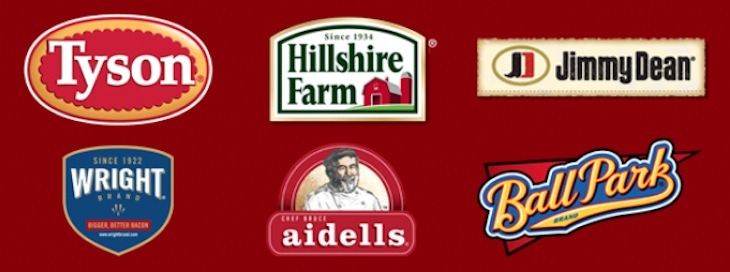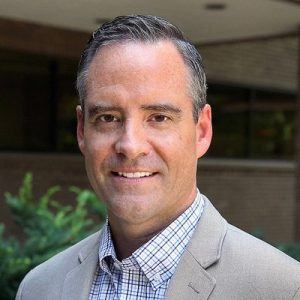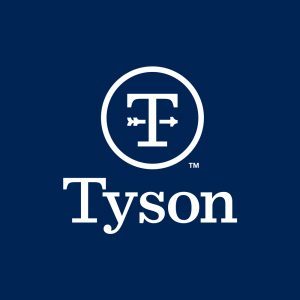Hayes’ Tyson 3.0 includes marketing overhaul, sustainability, new product pushes
by April 27, 2017 4:18 pm 1,393 views

Things are different with Tyson Foods CEO Tom Hayes. He’s more likely to wear a plaid dress shirt and dark pants than the traditional khaki duds worn by his predecessors. He’s not a Tyson veteran. And it’s the strength from difference he believes will pay off for the global meat giant.
Hayes was brought into the leadership circle when Hillshire Brands was acquired in 2014 in an $8.5 billion deal. Hayes was then the chief supply chain officer for Hillshire.
In his effort to update Tyson to a 3.0 version, Hayes recently told Talk Business & Politics what led to the organizational changes under his direction.
“We have different strengths,” Hayes said. “Tyson excelled in operations and Hillshire had an edge in marketing. We wanted to integrate the two businesses in a way that 1+1 = 3. We hadn’t up to this point fully asked ourselves what it meant to be working together. That’s what led us to create operational business units and marketing business units.”
He said the operational business unit focuses primarily on making sure the company is running as efficient as possible. The marketing division works with the operational unit to understand what types of products consumers want, seeks ways to innovate for the future and works on brand development.
While Tyson’s operational division was incredibly focused, Hayes said the marketing was conducted in somewhat isolated pockets. The company decided to create a business unit structure for retail and foodservice. Marketing strategies are now under one umbrella led by Andy Callahan for food service and Sally Grimes for retail.
He said the new marketing strategy doesn’t change the core of how Tyson operates, but it does put the company in a better position to plan for the future and be more sensitive about what food service customers and retail consumers want. He said company executives continue to talk about the two marketing channels so investors can get a sense of how the company is doing in those growth areas.
When asked what Tyson 3.0 will look like under his expanded marketing approach, Hayes referred back to what previous leaders Jim Lochner and Donnie Smith were able to accomplish when they turned the company around from deep challenges in 2008 and put it on a path for sustainable earnings and higher gross margins.

When asked what he plans to do about softer revenue projections for this year, Hayes said the focus is on quality products, higher operating margins and more volume. He said commodity prices will be what they will be, but if Tyson keeps margins high and sells more products, earnings will grow even when revenue is challenged, he said.
PUSHING NEW PRODUCTS
“The objective I have as the leader of Tyson now is to set the company up for the new stage of growth,” Hayes said. “There’s going to be continued changes in transparency demanded by consumers and higher expectations as it relates to sustainability. We will try and leverage the strength that we have from our past successes to fuel the next level of growth.”
That will include pushing more products to consumers because Hayes believes there is much growth opportunity for Tyson to expand retail offerings with HIllshire, Jimmy Dean, Ball Park and other key brands. The company announced in June plans to launch Tyson branded ground chicken at retail, hoping to win fast-food market share in a $46 billion market where it has not previously played. The product will be a value-added item carrying a higher margin and there will also be a marketing spend behind the launch featuring chicken tacos, chicken meatballs and chicken sliders.
The Tyson Tastemakers Launch into retail is coming in May in limited markets. He said the initial launch will be small and he didn’t say if Northwest Arkansas was one of the test areas. Hayes said Tyson wants to tiptoe into the retail space with Tastemakers in order to measure customer feedback and respond accordingly before going big.
“These are fresh products and they have very limited shelf life and we want to make sure we get a lot of things right before we go mass scale. It’s better to fix as you go than have to repair on the backend. We are incredibly excited about this launch. The products themselves take a step out of kitchen prep. If you think about our competitors in this space the consumer still has to do all the cooking. We are taking out some steps that allows consumers to make it faster and produce less waste,” Hayes said.
EXPANSION, ACQUISITION OPTIONS
When asked if Tyson planned to get Tastemaker meals on Walmart U.S. shelves, Hayes said he would love to see that once the meals are ready to go mainstream. Hayes also was also asked if Tyson might consider an acquisition of a Blue Apron or similar companies in the online direct-to-consumer meal sector. He dismissed the notion of direct-to-consumer being a large scale move for Tyson, saying the company plans to rely on its foodservice customers (vendors) to sell its products. When asked about the role of Tyson’s new venture capital fund, he said the focus there will be growing new brands of alternative protein such as plant-based foods. He said technology that advances the company’s sustainability plan are also of interest for the fund.
“Think of Tyson as all things protein. We know that 96% of U.S. consumers today want animal protein, but some will still want plant protein, which is why we are invested in that space,” Hayes said. “We want to be on the front end of this developing demand.”
That statement was prophetic in a sense given the company announced Monday (April 24) plans to divest of its non-protein brands – Sara Lee Frozen Bakery, Kettle and Van’s. Within the next 24 hours, Tyson announced plans to acquire AdvancePierre for $4.2 billion, giving it more convenience foods for its retail and foodservice businesses. Tyson said its commodity business will be the source for the AdvancePierre products helping to generate operational efficiencies and synergies of $200 million realized over the next three years.
SUSTAINABILITY PUSH
Hayes recently spoke about his vision for a more sustainable Tyson Foods. He said by investing in sustainability, Tyson expects “to create a virtuous cycle of contributing to the future while paying for itself in the present.” He said investments in sustainability should fund themselves through reduced waste and costs.
He told Talk Business & Politics the company plans to create a sustainable food system because it’s what consumers demand. He said Tyson is focused on not having trade-offs between healthy animals, a cleaner environment, safe work conditions and healthy food. He said Tyson wants to produce quality food in a sustainable way, sold at a price consumers can afford.
One area of sustainability change is with growing chickens. Hayes said 20 years from now chicken farms will look much different. The company is working on a concept farm of the future that seeks to conserve land and water, while also working to ensure better animal welfare.
ARKANSAS INVESTMENTS
Tyson has announced capital expenditures of about $1 billion this year. Hayes said some of that is in Arkansas. About $100 million is being spent to expand chicken production in Green Forest. Hayes said this work is the only plant investment in Arkansas and it will likely continue through most of this year.
He said the $31 million incubation center in Springdale is slated for completion later this year and work also continues on the renovation of three downtown buildings along Emma Avenue, where Tyson will relocate between 300 and 400 employees. He said there is also some renovation work at the corporate office in Springdale, updating offices, work areas and the cafeteria.
Hayes also said rumors are partially true that Tyson is moving some corporate jobs the Hillshire Brands office in Chicago. Hayes said about a year ago they moved the retail part of Tyson’s branded business to Chicago. He said the move is not ongoing.
“Chicago is a big consumer community with a larger talent pool related to the greater population,” he said.
Tyson has three main headquarters. The office in Dakota Dunes, S.D., manages the beef and pork business. The consumer businesses is run out of Chicago, and everything else is run from Springdale.

CORPORATE LOGO
When asked why Tyson needed a new corporate logo, Hayes said many of the products Tyson makes are not chicken, which the orange logo represents. He said the corporate logo is not for consumer identification as much as it is for internal use, and for customer and investors to stand out as a mark for the food company.
“We have three billion-dollar brands,” Hayes said. “One is Tyson, one is Hillshire Brands and the other is Jimmy Dean. The new logo is more about showing we are a modern food company with multiple brands rather than have it identified solely with chicken products. While we are proud of what we do in chicken we are equally proud of the other products we make.”
Hayes said customer response to the logo has been mostly positive. He said employees are also buying new apparel with the corporate logo at the company store. He said some worried about the new logo being too different from previous looks, but the logo is gaining momentum.
